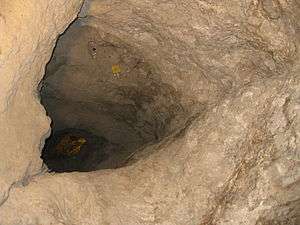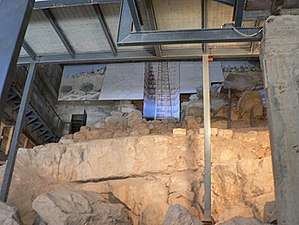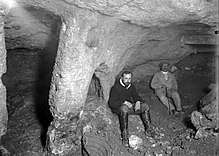Warren's Shaft
Warren's Shaft is a vertical shaft next to the Gihon Spring, the main source of water of Bronze and Iron Age Jerusalem, discovered in 1867 by British engineer and archaeologist, Sir Charles Warren (1840–1927). The term is currently used in either a narrower, or a wider sense:
- In the narrower, initial sense, Warren's Shaft is the almost vertical natural shaft leading down to a pool fed by the Gihon Spring.
- In the wider sense, as the Warren's Shaft system, it is the Bronze Age water system allowing protected access from the city to the Gihon Spring.



After the 19th-century discovery of the vertical natural shaft, it was thought to have been the centrepiece of the city's early water supply system, since it would have enabled the city's occupants to safely reach fresh water in times of siege. This view has been abandoned after recent archaeological excavation of the initial Bronze Age (Canaanite) and Iron Age (Judahite)
In 2005, archaeologists discovered the ruins of a pair of walls that would have protected the overland path to the spring prior to the tunnel's construction.
Discovery
The discovery was published by the Palestine Exploration Fund, in the form of a letter from Charles Warren on 12 December 1867. The letter ended: "The discovery of a shaft down to the water of the Virgin's Fount threw considerable light upon the object of the rock-cut canals about Jerusalem, as proving them as, had been conjectured by some, to have been for conducting away the refuse and blood from the temple.“[1]
Biblical reference
Since in the Books of Samuel (2 Samuel 5:8: 1 Chronicles 11:6) it states that David conquered Jerusalem from its prior inhabitants, the Jebusites, due to Joab sneaking up a similar water shaft and launching a surprise attack on the city from inside, it was long thought that Warren's shaft was the shaft in question (with the Siloam tunnel having too late a date, and there being no other known candidates). The narrow and tall almost vertical shaft was demonstrated to be traversable when a member of Warren's excavation climbed from top to base.
Water system overview
.jpg)
The wider meaning of the term includes four sections in sequence:
- a stepped tunnel
- a horizontal but curved tunnel
- a 14-metre-high vertical shaft (Warren's Shaft proper)
- a feeding tunnel
The shaft proper
According to a number of archaeologists, the vertical shaft is simply a widening of a natural fissure in the rock. The 14-metre-high shaft, which has a pool of water at the base, is now not actually thought to have been part of the Bronze or Iron Age water systems. The 14-metre shaft is too narrow, and the pool at its base too shallow, to have been functional, and archaeologists now believe that it is merely a natural fissure that the original excavators happened to breach during their dig towards the other pool.
The water system tunnels
In 1998, while a visitor centre was being constructed, builders discovered that there was an additional passageway, about 2 metres higher and starting from the horizontal curved tunnel, that skirted the 14 metre vertical shaft, and continued to a pool much nearer the Gihon spring. The higher passageway was not originally higher—at some point Warren's shaft was lowered (cutting into a geologically distinct type of rock), and ran into the 14-metre vertical shaft.
The spring pool and tower(s)
The pool reached by the higher passage was protected by a large tower, which was also discovered by the visitor centre builders, and is located outside the Bronze and Iron Age city. The pool connects to the Gihon Spring via a narrow channel, and the Gihon was itself protected by the already mentioned large tower. The pool itself may have been protected by a second tower, but this is uncertain as excavation of the southern side of the pool has not yet been carried out, since it lies under a current residential area.
Bronze Age date of the water system
Ceramics found in the tunnels by these more recent archaeological excavations firmly date the Warren's shaft system, and the tower defences, to at least the 18th century BCE. This expressly places it as having been developed in the time when Canaanites built their fortified city.
See also
- City of David, Jerusalem's core from the Bronze and part of the Iron Age; article gives an overview of the interconnected areas and water systems
- List of artifacts significant to the Bible
Connected structures and areas
- Jerusalem pilgrim road, monumental stepped street leading up towards the Temple mount
- Jerusalem Water Channel
- Givati Parking Lot dig, an adjacent and related excavation site